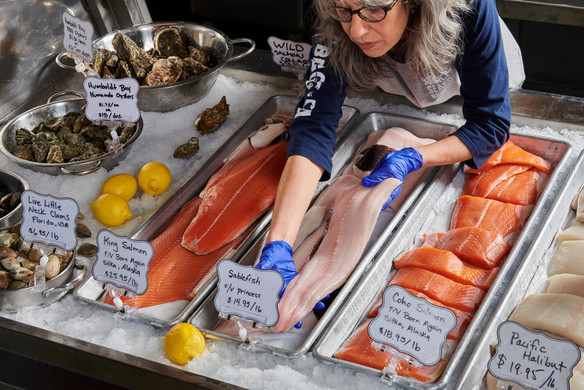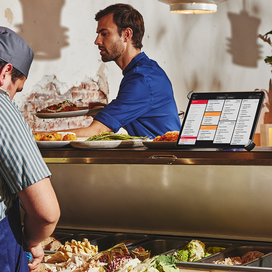Table of contents
This article is for educational purposes and does not constitute legal, financial, or tax advice. For specific advice applicable to your business, please contact a professional.
If you’re tracking your restaurant menu expenses, you know the time of year can make a difference. Halibut prices, for instance, tend to go up when seasonal migration patterns and fishing regulations create limited availability. And record inflation levels we’ve experienced in recent years make pricing conditions even more volatile. In a 2022 interview with CNBC, one restaurant owner explained that halibut cost more than $30 a pound, nearly double what it was the year prior.
Fluctuating costs of goods can make setting menu prices a risky challenge. If you set too low a price, you can miss out on a profitable sale for some months, but if you price a dish too high, you can turn guests away from the option altogether. In both scenarios, your restaurant can bring in fewer dollars.
A common solution that more restaurateurs are exploring is listing market price rather than a fixed dollar amount, which lets customers know the price of the meal depends on the seasonal cost of a key ingredient.
While this enables you to charge the amount you need to make a profit on that dish every time, seeing “market price” or “MP” next to an entree can make guests hesitant to order that dish for fear or uncertainty about the cost.
In an interview with US Today, Steven Wong, owner of Aqua Best, a seafood distributor in New York, explained, “I get asked about market price all the time. It takes me a while to explain to customers what it really means. People assume the dish will be expensive or that it gives restaurants a blank check to name any price. But that isn’t necessarily the case.”
Weather patterns, harvesting conditions, and supply and demand all contribute to fluctuating ingredient costs. Restaurant operators can weigh these factors to determine a fair market price. Then, with the right restaurant technology in place, you can transparently communicate your market price with guests and ultimately make menu decisions that benefit your business.
What is a market-price item? (And what are some examples?)
While many foods experience price fluctuations, not every dish on your menu should be a market-priced item to avoid alienating customers. Typically, a market-price listing is reserved for dishes with the most seasonal or variable ingredients. Many different kinds of seafood, including lobsters, oysters, and crab, are a good fit due to the price variability and seasonal aspects of the industry.
But other menu items, including certain fruit, vegetables, or meat, can also make a good market-price candidate as the cost of these goods shifts with the seasons and economic conditions.
Hamburgers and steaks, for example, are already at record-high prices and are expected to get even more expensive due to low cattle supply. Today, the number of cows used for beef is at its lowest level in six decades, which may make pricing beef-based dishes at a market price a worthwhile solution.
How to determine the price of a market-price item
While determining the dishes to consider for a market-price listing, ask yourself how the market-price item or items will align with the rest of your restaurant’s menu. Whether your restaurant has low-cost , mid-range, or more expensive offerings, think about how a market price will look among the other menu items listed.
Next, to calculate your market price, consider the cost of the raw food item. Sometimes this may be just a single ingredient, or it may mean multiple if more than one is subject to market price. As you compose the menu offering, think about the ideal cost percentage you would need in order to break even if a diner purchases the offering.
Raw Food Cost of Item / Food Cost Percentage = Market Price
Ultimately, leveraging market price on your menu will allow you to move that price both up and down as the market allows so that you don’t lose money on an item or price it exceedingly high for your customers.
If you are a Square seller using Square for Restaurants, you can check and organize menu items, adjust item counts, and mark them unavailable. Additionally, you can modify items and access diner history and preferences. These tools can not only help you track real-time inventory, helping you forecast how much of your market-price items will be in demand, but also allow you to make adjustments in real time to communicate changes to your customers.
Is market pricing right for you?
Using market pricing to determine a price for select items on your menu can help you make sure your costs are covered for offerings that require seasonal ingredients, hard-to-source ingredients, or ingredients with quickly fluctuating costs. These ingredients may appeal to a crowd looking for dishes featuring them and entice them to pay a little more in order to enjoy them.
On the other hand, listing a menu item as market price rather than the dollar amount may intimidate potential customers. As you weigh your options on what might work best for your restaurant and your customers, consider which items are critical to your menu and how you can communicate their value to your diners.
There are several different types of additional pricing strategies you can employ to account for menu items that fluctuate in price. From dynamic pricing to a more streamlined prix fixe menu, these strategies can help your restaurant manage costs more closely.
![]()












